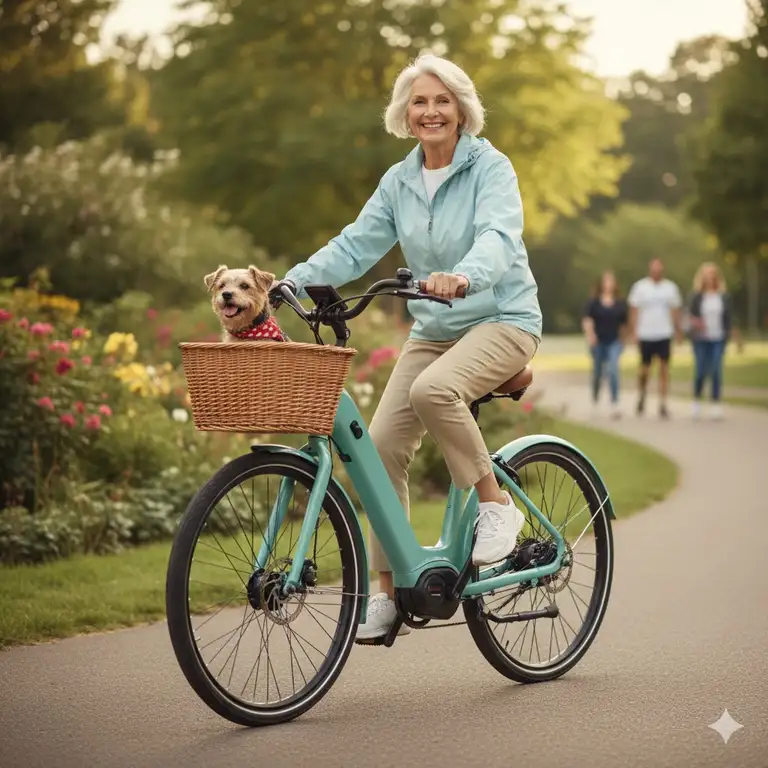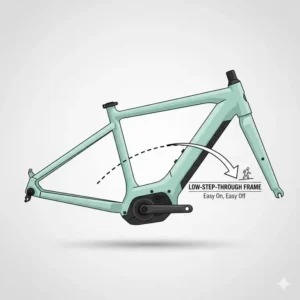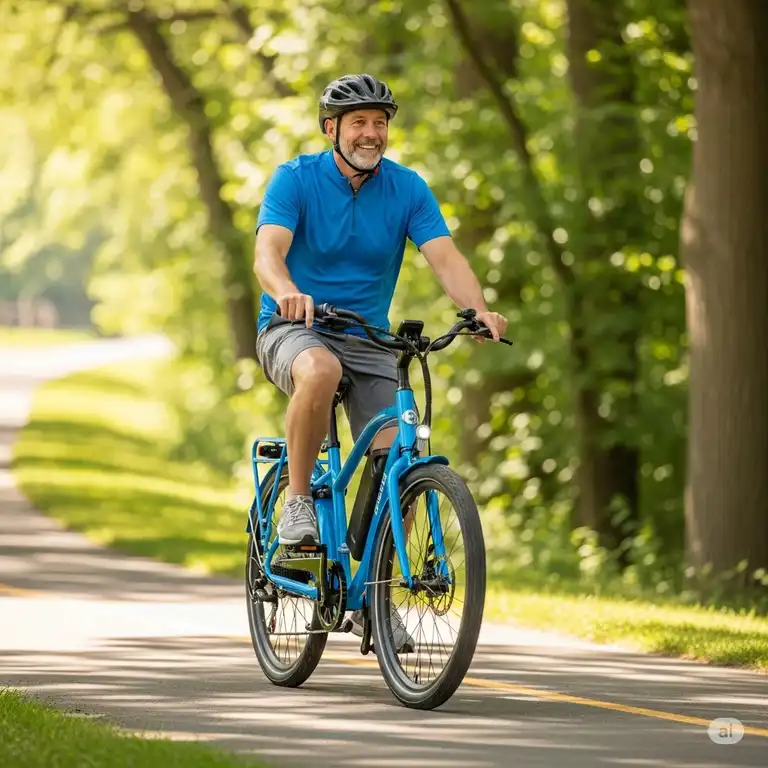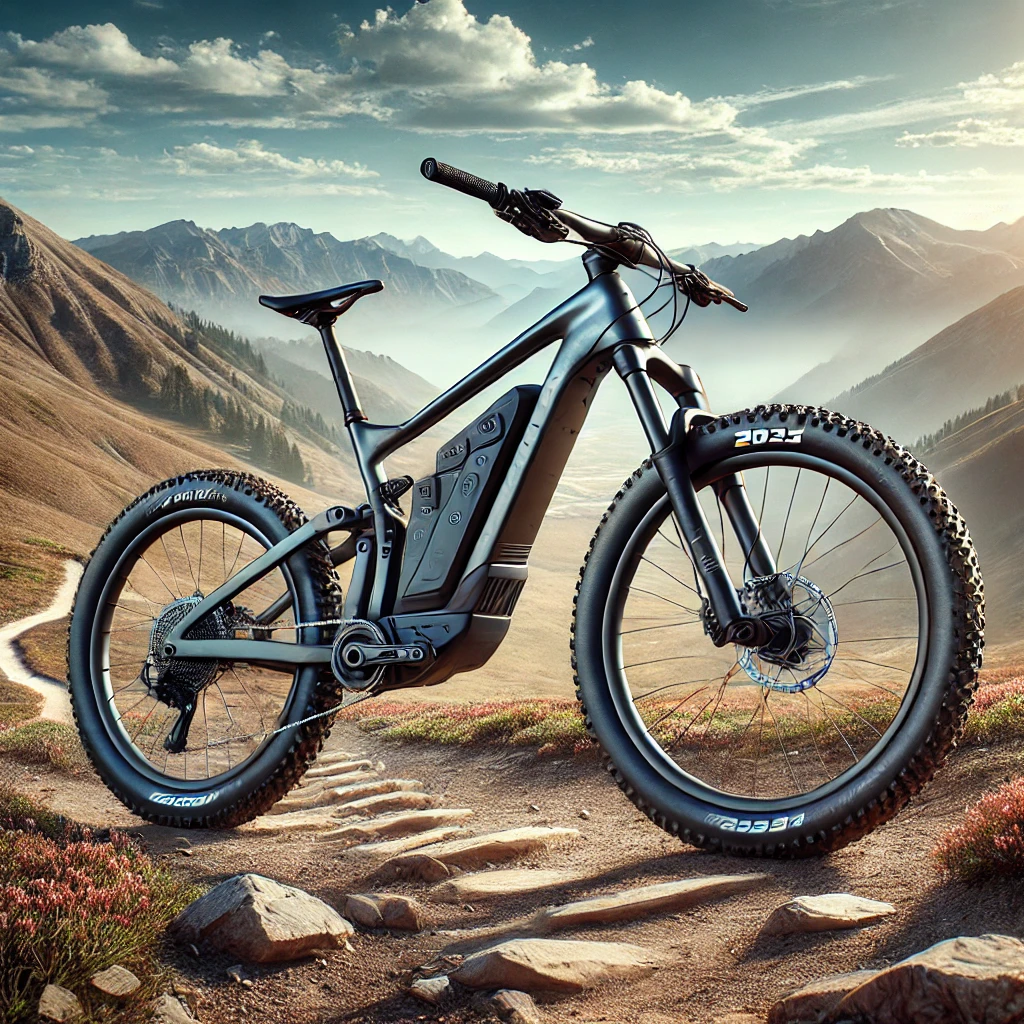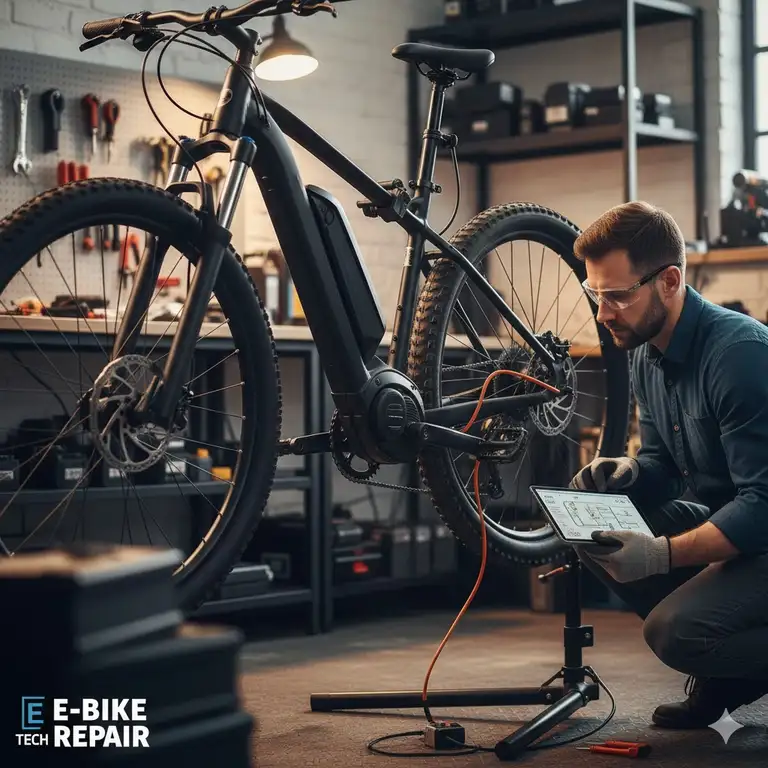You know that feeling when you pass by a bike shop and feel a little pang of nostalgia? Maybe you’re remembering those carefree rides through the neighborhood, wind in your hair, not a care in the world. But then reality hits—balance isn’t what it used to be, and the thought of straddling a traditional bike feels more like a recipe for disaster than a joyride.
✨Was this helpful? Spread the word! 🚀
Here’s the good news: the best e bikes for seniors with balance issues are changing the game completely. I’m not talking about clunky, medical-looking contraptions that scream “I’ve given up on fun.” These are legitimate, stylish rides that combine cutting-edge electric assistance with stability features designed specifically for folks who need a little extra confidence.
Recent statistics show that a third of new American bike riders are over 60, and in England, more than half of all electric bikes are purchased by folks over 55. This isn’t some niche market—it’s a full-blown revolution. Seniors today aren’t looking to fade quietly; they’re seeking adventure, independence, and yes, that wind-in-your-hair feeling again.
The challenge? Not all e bikes are created equal. Some are too heavy, others too powerful, and many completely ignore the unique needs of riders with balance concerns. That’s where this guide comes in. After extensive research and analysis of real customer feedback, I’ve identified the best e bikes for seniors with balance issues that actually deliver on safety, comfort, and performance.
Quick Comparison: E Bikes vs. Traditional Bikes for Seniors
| Feature | Best E Bikes for Seniors | Traditional Bikes |
|---|---|---|
| Balance Support | ✅ Three-wheel options, low center of gravity, wide tires | ❌ Requires continuous balance, higher risk |
| Physical Effort | ✅ Motor assistance reduces strain on joints | ❌ Full pedaling effort required |
| Hill Climbing | ✅ Effortless with electric motor | ❌ Challenging, especially for seniors |
| Mounting/Dismounting | ✅ Step-through frames, low standover height | ❌ Often requires high leg lift |
| Speed Control | ✅ Adjustable pedal assist levels, throttle option | ❌ Speed depends entirely on physical ability |
| Stability at Stops | ✅ Trikes stay upright, wider tires provide support | ❌ Must balance or dismount |
| Range of Travel | ✅ 25-85 miles per charge | ❌ Limited by physical stamina |
| Safety Features | ✅ Lights, reflectors, hydraulic brakes, parking brakes | ❌ Basic brakes, limited visibility features |
Top 7 Best E Bikes for Seniors with Balance Issues: Expert Analysis
After analyzing dozens of models and reading hundreds of customer reviews, I’ve identified seven outstanding options that cater specifically to seniors with balance concerns. Each offers unique features, but all share core attributes: stability, ease of use, and reliable performance.
1. EMOJO Caddy Pro – Premium Electric Tricycle for Ultimate Stability
Motor: 500W (front hub)
Battery: 48V 15.6Ah
Range: Up to 35-45 miles
Weight Capacity: 330 lbs
The EMOJO Caddy Pro represents the gold standard in electric tricycles for seniors with balance issues. This UL2849-certified trike features hydraulic disc brakes, front suspension fork, comfortable oversized seat with backrest, and 7-speed transmission.
What sets this trike apart is its fat tire design—20″ x 4.0″ wheels provide exceptional stability on various surfaces from city streets to light trails. The three-wheel configuration completely eliminates balance concerns, while the step-through frame makes mounting and dismounting effortless.
Pros:
✅ Hydraulic brakes require less hand strength
✅ Front and rear cargo baskets included
✅ UL safety certification provides peace of mind
✅ Comfortable backrest seat for long rides
✅ 7-speed transmission handles hills easily
Cons:
❌ Heavier than two-wheel options (around 75 lbs)
❌ Wider turning radius due to trike design
❌ Assembly can be challenging without help
Best For: Seniors who prioritize absolute stability and cargo capacity over portability.
2. Schwinn Meridian Adult Tricycle – Classic Reliability Without Breaking the Bank
Motor: None (pedal-powered)
Wheels: 24″ or 26″ options
Weight Capacity: 300 lbs
Don’t let the lack of electric assistance fool you—the Schwinn Meridian Adult Tricycle earns its place on this list as a budget-friendly gateway option. This full-sized tricycle features three wheels for stability, a low step-through aluminum frame, adjustable handlebars, and a large comfort cruiser saddle.
The 24″ wheel option suits riders from 4’8″ to 5’6″, while the 26″ wheels accommodate heights from 5’4″ to 6’2″. The single-speed drivetrain keeps things simple, and the rear folding basket holds groceries, bags, or picnic supplies.
While it requires pedaling effort, the three-wheel design provides unmatched stability for flat terrain riding. Many seniors use this as their introduction to tricycles before upgrading to electric models.
Pros:
✅ Extremely affordable entry point
✅ Multiple color options available
✅ Proven Schwinn quality and durability
✅ Large rear basket for cargo
✅ Low maintenance single-speed design
Cons:
❌ No electric assistance for hills
❌ Heavier than traditional bikes
❌ Limited to flat terrain without e-assist
Best For: Budget-conscious seniors on flat terrain who want to test tricycle riding before investing in electric.
3. Jasion EB5 – Best Value Electric Mountain Bike with Accessibility
Motor: 350W (750W peak)
Battery: 360Wh
Range: 25-40 miles
Top Speed: 20 MPH
The Jasion EB5 electric bike strikes an impressive balance between affordability and features. This electric mountain bike includes a 750W peak motor, 360Wh removable battery, 7-speed transmission, 26″ puncture-resistant tires, and front fork suspension.
What makes the Jasion EB5 particularly suitable for seniors with balance issues is its lightweight design (49.6 lbs) combined with a low standover height. The upgraded LCD display is large and easy to read, showing essential information at a glance. Four working modes include pedal assist, pure electric, pedal only, and booster mode for walking the bike uphill.
The bike delivers 25-40 miles on a single charge depending on assist level, and the removable battery charges in 5-6 hours. While it’s a two-wheeled design, the wide tires and low center of gravity provide enhanced stability compared to traditional bikes.
Pros:
✅ Exceptional value under $600
✅ Lightweight and easy to handle
✅ Removable battery for convenient charging
✅ Front suspension smooths rough roads
✅ 7-speed gearing handles varied terrain
Cons:
❌ Two-wheel design requires some balance ability
❌ Battery capacity lower than premium models
❌ Assembly requires mechanical aptitude
Best For: Seniors with mild balance concerns who want an affordable electric bike for neighborhood rides.
4. Qlife Triker – Folding Electric Tricycle with Rear Differential
Motor: 750W peak
Battery: 468Wh (36V 13Ah)
Range: Up to 50 miles
Weight Capacity: 400 lbs
The Qlife Triker electric bike combines the stability of three wheels with impressive folding capability. This UL2849-certified trike features a differential mechanism that allows each rear wheel to rotate at different speeds during turns, enhancing maneuverability and stability.
The folding frame is a game-changer for seniors with limited storage space or who want to transport the trike in a vehicle. When folded, it measures just 31.5″ L x 21.5″ H x 23.6″ W—compact enough for most car trunks and standard elevators.
Front and rear baskets provide ample cargo capacity, while the step-through design ensures easy mounting. The 20″ x 1.95″ tires deliver reliable traction on diverse surfaces from city streets to grassy parks.
Pros:
✅ Folds for easy storage and transport
✅ Rear differential improves cornering
✅ Long 50-mile range
✅ 400 lb weight capacity
✅ Front fork suspension for comfort
Cons:
❌ Heavier when folded (93 lbs)
❌ More expensive than non-folding trikes
❌ 16 mph top speed lower than some models
Best For: Seniors who need portability without sacrificing three-wheel stability.
5. YITAHOME Adult Tricycle – Comfort-Focused Design with Backrest
Motor: Optional (1-speed or 7-speed)
Wheels: 24″ or 26″
Weight Capacity: 350 lbs
The YITAHOME Adult Tricycle stands out for its ergonomic design focused on rider comfort. This tricycle features a low step-through frame, large seat with backrest, front and rear baskets, and options for both 1-speed and 7-speed configurations.
The backrest is a crucial feature for seniors with back pain or posture issues. It provides lumbar support during longer rides, reducing fatigue and allowing for extended cycling sessions. The wide, cushioned saddle further enhances comfort.
Multiple color options let you express personal style, while the sturdy construction handles riders up to 350 lbs. Whether you choose the simple 1-speed for flat terrain or the versatile 7-speed for varied landscapes, this trike delivers reliable performance.
Pros:
✅ Backrest provides excellent lumbar support
✅ Very affordable pricing
✅ Multiple speed options available
✅ Front and rear storage baskets
✅ Wide color selection
Cons:
❌ No electric assist option
❌ Assembly instructions could be clearer
❌ Heavier than comparable models
Best For: Seniors seeking maximum comfort on a traditional tricycle with excellent back support.
6. Nakto Pony – Compact Electric Cargo Bike
Motor: 250W (36V)
Battery: 36V 10Ah
Range: 25-30 miles
Top Speed: 22 MPH
Don’t be fooled by its compact size—the Nakto Pony step through electric bicycle packs impressive functionality into a smaller frame. This cargo electric bike features 20-inch wheels, step-through frame, front and rear metal racks, spring-supported oversized saddle, and both throttle and pedal assist.
The Pony’s compact design makes it incredibly maneuverable in tight spaces and easy to store. The lower standover height (thanks to 20″ wheels) provides confidence when mounting and dismounting, while the step-through frame eliminates awkward leg lifts.
Front and rear cargo racks transform this bike into a practical shopping companion. At around $700, it positions itself among the most cost-effective electric bikes available, making it an excellent entry point for seniors exploring electric cycling.
Pros:
✅ Extremely affordable under $800
✅ Compact size easy to store
✅ Front and rear cargo racks included
✅ Lightweight and maneuverable
✅ Step-through frame for easy access
Cons:
❌ Lower motor power (250W) struggles on steep hills
❌ Smaller wheels less stable than 26″ options
❌ Basic component quality
Best For: Seniors in urban environments who prioritize affordability and compact design for short errands.
7. Heybike Ranger S – Premium Folding Step-Through with Smart Features
Motor: 750W (1400W peak)
Battery: 48V 14.4Ah (720Wh)
Range: Up to 55 miles
Top Speed: 28 MPH
The Heybike Ranger S electric bike for adults represents the cutting edge of folding electric bike technology. This step-through e-bike features a 750W motor (1400W peak), 720Wh removable battery, 20″ x 4.0″ fat tires, hydraulic front fork, and smart lighting system.
What truly sets the Ranger S apart is its technology integration. The Heybike app provides anti-theft features, firmware updates, personalized settings, riding statistics, and auto lock/unlock when approaching or leaving the bike. The smart lighting system automatically activates in low-light conditions, while turn signals clearly communicate your intentions to other riders and drivers.
The folding capability makes it practical for RV travel, apartment living, or car trunk transport. Despite its 72 lb weight, the sturdy aluminum alloy frame supports riders from 4’11” to 6’3″ with a 400 lb total payload capacity.
Pros:
✅ Powerful motor handles steep hills
✅ Long 55-mile range
✅ Smart app integration
✅ Automatic lights and turn signals
✅ Folds for storage/transport
Cons:
❌ Heavy for a folding bike (72 lbs)
❌ Higher price point
❌ Battery level indicator can fluctuate
Best For: Tech-savvy seniors who want premium features and don’t mind investing in quality.
✨ Don’t Miss These Exclusive Deals! 🎁
Ready to reclaim your riding freedom? These carefully selected e bikes for seniors with balance issues are available now on Amazon. Click on any highlighted product name above to check current pricing, read verified customer reviews, and take advantage of any active promotions. Many models offer free shipping and easy returns, giving you confidence in your purchase. Don’t let balance concerns keep you off the road—these innovative designs are specifically engineered to restore your independence and joy of riding!
💬 Just one click – help others make better buying decisions too!😊
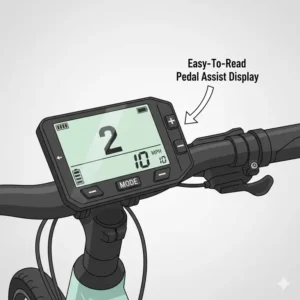
Understanding Balance Issues: Why Traditional Bikes Don’t Work
Let’s talk about what’s really happening when balance becomes a concern. It’s not just “getting older”—it’s a complex interplay of physiological changes that affect coordination, muscle strength, and sensory input.
The Science Behind Balance Challenges
Balance and mobility issues become more prevalent with age due to changes in the vestibular system, reduced muscle mass, decreased flexibility, and slower reaction times. The inner ear, which controls balance, naturally deteriorates over time. Vision changes affect depth perception. Medications can cause dizziness or unsteadiness.
Traditional bicycles require continuous micro-adjustments to maintain balance—thousands of tiny corrections every minute that your brain processes automatically when you’re younger. As we age, this processing slows down, making those adjustments less automatic and more effortful.
Key Factors in E Bike Selection for Balance Issues
| Factor | Why It Matters | What to Look For |
|---|---|---|
| Center of Gravity | Lower = more stable | Step-through frames, 20″ wheels, recumbent designs |
| Wheel Configuration | Three wheels eliminate balancing | Delta (two rear) or tadpole (two front) trikes |
| Tire Width | Wider = more contact patch | 3.0″-4.0″ fat tires provide maximum stability |
| Frame Geometry | Upright position aids balance | Relaxed angles, swept-back handlebars |
| Weight Distribution | Rear-biased improves stability | Mid-drive or rear hub motors, low-mounted batteries |
| Standover Height | Lower = easier mounting | Step-through designs under 12″ height |
Essential Features to Look For
When shopping for the best e bikes for seniors with balance issues, certain features aren’t optional—they’re essential for safety and confidence.
1. Step-Through Frame Design ⚡
A step-through frame (also called low-step or wave frame) eliminates the high top tube found on traditional bikes. Instead of swinging your leg over a bar, you simply step through the open frame.
Why it matters: A step-through frame is particularly beneficial for seniors with mobility and balance challenges because it provides easier access to the bike, reducing the risk of tripping or falling. You can mount with both feet remaining near the ground, maintaining stability throughout the process.
Look for: Standover heights under 10-12 inches, curved or completely open frame designs, and reinforced tubing that maintains structural integrity despite the open design.
2. Three-Wheel Configuration 🚴♂️
Three-wheel bikes (trikes) provide more stability than traditional bikes by having a third wheel, eliminating the need to balance while stationary or riding slowly. Unlike two-wheelers that require constant balance, trikes stay upright automatically.
Delta vs. Tadpole Design:
- Delta trikes (two wheels rear, one front) are most common for seniors. They offer tight turning circles and familiar handling.
- Tadpole trikes (two wheels front, one rear) provide even more stability but are less common in senior-focused models.
3. Wide, Low-Pressure Tires 🔋
Fat tires (typically 3.0″ to 4.0″ wide) provide multiple benefits for balance-challenged riders:
Stability: Wider contact patch with ground improves stability, especially at low speeds
Shock Absorption: Lower pressure soaks up bumps that could throw off balance
Traction: Better grip on loose surfaces like gravel or wet pavement
Confidence: The visual bulk reassures riders and feels more planted
Wide, low-pressure tires provide better shock absorption, ensuring a smoother ride over uneven surfaces like cracks or bumps on roads and paths.
4. Adjustable Components ✅
One size definitely doesn’t fit all when it comes to the best e bikes for seniors with balance issues. Look for:
Adjustable saddle: Height and angle adjustment ensures proper leg extension and comfortable position
Handlebar reach: Ability to bring bars closer reduces back strain
Backrest options: Many trikes offer adjustable backrests for lumbar support
Pedal position: Some models allow forward/back pedal adjustment
5. Powerful Yet Controllable Motor 🔋
Motor power needs to hit a sweet spot: enough power to assist meaningfully, but not so much that it feels overwhelming.
Ideal specifications:
- 350W-750W nominal power (sufficient for most terrain)
- Multiple pedal assist levels (typically 3-5 settings)
- Throttle option for starting from stops
- Smooth power delivery without sudden surges
A motor between 500W and 1000W provides enough power for help without being too much to handle. The key is progressive power delivery that feels natural, not jarring starts that could affect balance.
6. Reliable Braking System 🚲
Hydraulic brakes require less force to engage and deliver force more evenly, meaning a light pull produces strong braking response without pressing as hard. This is crucial for seniors with reduced hand strength or arthritis.
Brake types comparison:
- Hydraulic disc brakes: Best option—powerful, require less hand strength, perform well in all weather
- Mechanical disc brakes: Good middle ground—reliable stopping power, more affordable
- V-brakes/rim brakes: Adequate for flat terrain, require more hand strength
- Drum/coaster brakes: Easy to use but less stopping power
Special feature: Parking brakes on trikes prevent rolling on inclines—essential for safety.
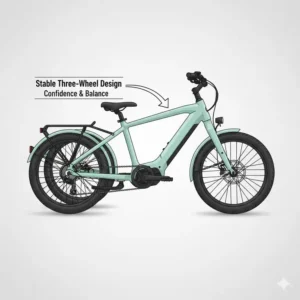
Comparison: Electric Bikes vs. Electric Trikes
This comparison helps you decide between two-wheel and three-wheel options based on your specific needs.
| Feature | Electric Bikes (2 Wheels) | Electric Trikes (3 Wheels) |
|---|---|---|
| Stability | Moderate—requires balance ability | Excellent—self-supporting |
| Ease of Use | Requires some cycling experience | Intuitive for beginners |
| Maneuverability | Excellent—narrow and nimble | Good—wider turning radius |
| Storage | Minimal space required | More space needed |
| Portability | Lighter, easier to transport | Heavier, challenging to lift |
| Speed | Typically faster (up to 28 mph) | Usually capped at 15-20 mph |
| Cargo Capacity | Limited without accessories | Built-in baskets, high capacity |
| Price Range | $500-$2,000 | $800-$3,500 |
| Best For | Mild balance concerns, want speed | Significant balance issues, cargo needs |
Motor Power and Battery Life Explained
Understanding motor power and battery capacity helps you choose the right e bike for your terrain and distance needs.
Motor Power Ratings Demystified
| Motor Power | Best For | Typical Performance |
|---|---|---|
| 250W | Flat terrain, light riders | Assists up to 15 mph, struggles on hills |
| 350W | Gentle hills, average riders | Comfortable 18-20 mph, handles moderate inclines |
| 500W | Moderate hills, heavier riders | Strong acceleration, 20-22 mph, good hill climbing |
| 750W | Steep hills, cargo hauling | Powerful assist, 22-28 mph, conquers most terrain |
Important note: Advertised “peak” power (often 2x nominal) represents maximum short-term output, not sustained performance. A “750W peak” motor might only provide 350-500W continuously.
Battery Capacity and Real-World Range
Battery capacity is measured in watt-hours (Wh), which determines how far you can travel per charge.
| Battery Capacity | Expected Range | Best For |
|---|---|---|
| 300-400Wh | 20-30 miles | Short errands, daily neighborhood rides |
| 400-500Wh | 30-45 miles | Longer recreational rides, weekly shopping |
| 500-720Wh | 45-60 miles | All-day adventures, commuting |
| 720Wh+ | 60-85+ miles | Extended tours, minimal charging anxiety |
Real-world factors affecting range:
- Rider weight: Heavier riders consume more battery
- Terrain: Hills drain batteries faster
- Assist level: Higher assist = shorter range
- Tire pressure: Underinflated tires increase resistance
- Weather: Headwinds and cold temperatures reduce range
- Stop/start frequency: City riding with many stops uses more power
Pro tip: Expect to achieve about 60-70% of manufacturer’s advertised range in real-world mixed conditions.
Safety Features That Matter
Safety isn’t just about preventing accidents—it’s about building confidence that lets you actually enjoy riding.
Essential Safety Features Checklist
✅ Bright LED headlight and taillight (preferably with auto-on feature)
✅ Reflective materials on frame, fenders, and tires
✅ Turn signals (increasingly common on premium models)
✅ Bell or horn to alert pedestrians
✅ Hydraulic brakes for reliable stopping power with less hand effort
✅ Kickstand or parking brake to prevent rolling
✅ Low center of gravity for stability
✅ Wide handlebars for better control
✅ Rearview mirrors to see approaching traffic (often sold separately)
✅ Fenders to keep you clean and dry
Health Benefits of E Biking for Seniors
Electric bikes help improve health and fitness in seniors, especially for those with physical limitations that make regular cycling difficult. Here’s what the research shows:
Cardiovascular Health ❤️
Cycling is a great form of cardiovascular exercise that can improve heart health and circulation. E bikes allow you to control intensity—start with high assist and gradually reduce it as fitness improves.
Benefits:
- Lowers blood pressure
- Improves cholesterol levels
- Reduces heart disease risk
- Increases aerobic capacity
Joint-Friendly Exercise 🦴
Unlike running or high-impact activities, cycling is low-impact and gentle on joints. The electric motor reduces physical strain on knees, hips, and cardiovascular system while still providing meaningful exercise.
Mental Health and Social Connection 🧠
Getting outdoors, feeling independent, and connecting with cycling communities provides significant mental health benefits:
- Reduces anxiety and depression
- Improves mood through endorphin release
- Combats loneliness through group rides
- Boosts confidence and self-esteem
- Provides sense of purpose and adventure
Balance and Coordination Improvement 💪
Ironically, riding an e bike—even a trike—can actually help improve balance over time. The act of steering, shifting weight, and coordinating movements provides gentle balance training in a safe environment.
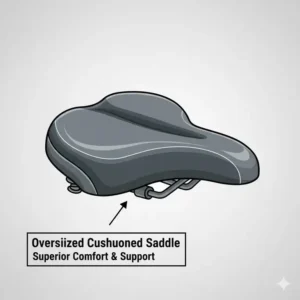
Price Ranges and Value Considerations
Understanding pricing helps you set realistic expectations and find the best value for your budget.
Budget Tier: $500-$1,000
What you get:
- Basic electric assistance (250-350W motors)
- Smaller batteries (300-400Wh)
- Mechanical disc or V-brakes
- Simple LCD displays
- Limited features
Best options:
- Jasion EB5 (~$550-650)
- Nakto Pony (~$700-800)
- Schwinn Meridian (non-electric) (~$400-500)
Trade-offs: Components may be lower quality, shorter warranties, basic features only.
Mid-Range: $1,000-$2,000
What you get:
- More powerful motors (500-750W)
- Larger batteries (500-720Wh)
- Better components (hydraulic brakes, suspension)
- Enhanced displays
- Additional features (lights, fenders, racks)
Best options:
- Qlife Triker (~$1,000-1,200)
- YITAHOME with accessories (~$800-1,000)
- Heybike Ranger S (~$1,200-1,500)
Sweet spot: This range offers the best balance of features, quality, and affordability for most seniors.
Premium: $2,000-$4,000+
What you get:
- Highest power motors (750W+ with 1400W peaks)
- Massive batteries (720Wh-960Wh)
- Premium components throughout
- Advanced safety features
- Long warranties and superior support
Best options:
- EMOJO Caddy Pro (~$2,000-2,500)
- ADDMOTOR ARISETAN M-360 (~$2,500-3,500)
Worth it if: You plan to ride frequently, need maximum range and comfort, or have specific health requirements demanding premium features.
Total Cost of Ownership
Don’t forget ongoing costs:
- Electricity: ~$0.10-0.20 per charge (incredibly cheap!)
- Maintenance: $100-300/year (tires, brakes, chain)
- Battery replacement: $300-600 every 3-5 years
- Insurance: Optional, ~$100-200/year
- Accessories: Helmet, lock, mirrors, basket liners ($100-300 initial)
Bottom line: Even premium e bikes cost far less than car ownership and provide better health benefits than gym memberships.
Maintenance Tips for Longevity
Proper maintenance keeps your e bike running smoothly and extends its lifespan significantly.
Weekly Checks (5 minutes)
🔧 Tire pressure: Maintain recommended PSI (check sidewall)
🔧 Brake function: Test both brakes before each ride
🔧 Battery charge: Don’t let battery fully deplete
🔧 Lights: Verify all lights working
🔧 Quick visual inspection: Look for loose parts or damage
Monthly Maintenance (30 minutes)
🔧 Chain lubrication: Clean and lubricate chain
🔧 Bolt tightness: Check and tighten all bolts
🔧 Brake pad inspection: Look for wear
🔧 Tire tread: Check for wear or damage
🔧 Battery connections: Ensure clean, tight connections
Seasonal Service (Professional)
🔧 Comprehensive inspection: Let a bike shop check everything
🔧 Brake adjustment: Professional brake tuning
🔧 Derailleur adjustment: Smooth gear shifting
🔧 Deep cleaning: Professional wash and detail
🔧 Software updates: Update motor/display firmware if applicable
Battery Care for Maximum Lifespan
Do:
✅ Store at 40-80% charge for long periods
✅ Charge in moderate temperatures (50-70°F)
✅ Use manufacturer’s charger only
✅ Charge after every ride
Don’t:
❌ Let battery fully discharge regularly
❌ Store in extreme temperatures
❌ Leave on charger for days after full charge
❌ Use third-party chargers
Proper battery care can extend lifespan from 500 to 800+ charge cycles.
Common Concerns Addressed
“Aren’t e bikes just for lazy people?”
Absolutely not. Electric bikes reduce physical strain on knees, hips, and the cardiovascular system while still providing meaningful exercise. They’re tools that enable activity that wouldn’t otherwise be possible.
Studies show e bike riders actually exercise more frequently than traditional cyclists because the reduced barriers mean they ride more often. More frequent moderate exercise beats occasional intense exercise.
“Will I look silly on a tricycle?”
Modern electric trikes are stylish, sleek, and increasingly common. You’ll see doctors, lawyers, retirees, and everyone in between riding them. Function and safety trump fashion—but honestly, many current trikes look fantastic.
More importantly: enjoying life, staying active, and maintaining independence is never silly.
“Is it hard to learn?”
If you can walk, you can ride an e bike or trike. Three-wheelers require zero balance—you literally just sit and pedal (or throttle). Two-wheelers with step-through frames are nearly as easy.
Most riders report feeling comfortable within their first 15-30 minutes. Start in a parking lot or quiet street, practice starting/stopping, and build confidence gradually.
“What about hills?”
This is where e bikes shine. With a strong motor (500W+), hills are no problem—just use pedal assist as needed. Motors provide extra power exactly when you need it, making previously impossible hills manageable.
Riders consistently report that hills become fun instead of dreaded obstacles.
“How far can I actually go?”
Real-world range depends on many factors, but expect:
- Low assist, flat terrain: 80-90% of advertised range
- Medium assist, mixed terrain: 60-70% of advertised range
- High assist, hilly terrain: 40-50% of advertised range
Most daily errands fall within 5-10 miles—well within any e bike’s range.
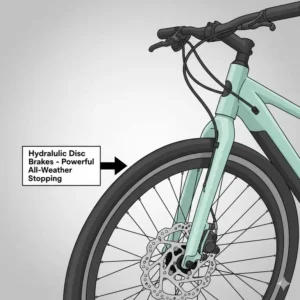
Real User Stories
Margaret, 72, Wisconsin “After my hip surgery, I thought my biking days were over. Then my daughter bought me the EMOJO Caddy Pro. I’ve been riding almost daily for six months now—grocery shopping, visiting friends, even a 15-mile trail ride last week! The three wheels mean I never worry about tipping, and the electric assist means hills don’t exist anymore. It’s given me my independence back.”
Robert, 68, Florida “I was skeptical about spending money on an e bike, but the Heybike Ranger S has been worth every penny. I fold it up and take it in my RV when we travel. The automatic lights and turn signals make me feel safe, and the app tracking lets my wife see where I am on longer rides. I’m riding 20-30 miles per week now—more than I did when I was 50!”
Susan & Tom, 71 & 74, Arizona “We bought matching Jasion EB5 bikes two years ago. Best investment we’ve made in retirement. We ride together every morning before it gets hot—usually 5-8 miles. My arthritis doesn’t bother me on the bike like it does walking. Tom has balance issues from his stroke, but the wide tires and low frame give him confidence. We’ve met so many people in our cycling group. It’s become our social life.”
Where to Buy: Amazon vs. Specialty Shops
Amazon Advantages
✅ Convenience: Delivery to your door, often free shipping
✅ Price: Often competitive pricing, frequent sales
✅ Reviews: Thousands of verified customer reviews
✅ Returns: Generally easy return policies
✅ Selection: Massive variety in one place
Downsides:
❌ Self-assembly required (though many models are 85-90% assembled)
❌ Limited expert advice
❌ No test rides
Local Bike Shop Advantages
✅ Expert guidance: Professional fitting and recommendations
✅ Test rides: Try before you buy
✅ Assembly: Fully assembled and tuned
✅ Local support: Easy service and maintenance
✅ Relationships: Build connection with local experts
Downsides:
❌ Usually higher prices
❌ Limited selection
❌ May not stock senior-specific models
My recommendation: Research extensively online (including reading detailed reviews like this), then visit local shops to test ride similar models if possible. Purchase where you’re most comfortable, but favor shops offering good post-purchase support.
Accessories You’ll Want
Essential Safety Gear
🪖 Helmet: Non-negotiable. Look for CPSC-certified models with MIPS technology ($50-150)
🔒 Lock: U-lock or heavy chain for security ($40-100)
🎽 Reflective vest: Increases visibility dramatically ($15-30)
🧤 Gloves: Padding reduces hand fatigue, improves grip ($20-40)
Comfort Enhancements
🪑 Upgraded saddle: Gel or memory foam seats ($30-80)
📱 Phone mount: Navigation and safety ($15-30)
🔊 Better bell/horn: Loud enough to be heard ($10-25)
☂️ Weather gear: Rain jacket, panniers with covers ($50-150)
Storage Solutions
🧺 Pannier bags: Side-mounted bags for grocery runs ($40-100)
🎒 Front basket liner: Keeps small items from falling through ($15-25)
🔌 Extra battery: For extended range (if available for your model, $300-600)
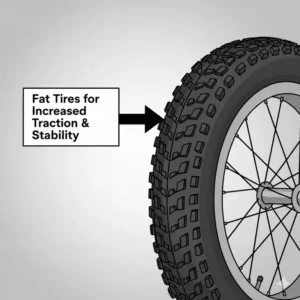
Frequently Asked Questions
How fast do electric bikes for seniors go?
Most e bikes for seniors have top speeds between 15-28 mph, though many can be limited to slower speeds for comfort. The EMOJO Caddy Pro, designed with safety in mind, has a maximum speed of 20 MPH, perfectly balancing power and safety while being street legal. Tricycles typically cap at 15-20 mph for stability, while two-wheelers may reach 20-28 mph depending on motor power and local regulations.
Can I ride an e bike if I’ve never cycled before?
Absolutely! Three-wheel electric trikes require no previous cycling experience—if you can walk, you can ride a trike. The three-wheel design means you never need to balance, and electric assistance means you don’t need to be physically fit. Many seniors take up cycling for the first time in their 60s and 70s with great success.
What’s the weight limit on these bikes?
Weight capacities vary by model:
- Budget bikes/trikes: 250-300 lbs
- Mid-range models: 300-350 lbs
- Premium trikes: 350-450 lbs
The ADDMOTOR M-360 leads with 380 lbs total capacity (280 lbs rider + 100 lbs cargo), while the Heybike Ranger S supports 400 lbs total payload. Always check specific model specifications.
Do I need a license or registration?
In most U.S. states, e bikes classified as “Class 1” (pedal assist only, max 20 mph) or “Class 2” (throttle allowed, max 20 mph) require no license, registration, or insurance. Models designed to be street legal ensure you can enjoy your ride without worrying about exceeding road speed limits.
Some states require riders to be 16+ years old. Check your local regulations, as rules vary by state and municipality.
How long does the battery last?
Battery lifespan is measured in two ways:
Per-charge range: 25-85 miles depending on model, terrain, assist level, and rider weight
Total lifespan: 500-800 charge cycles (3-5 years with normal use)
Proper battery care extends lifespan significantly. Expect to replace the battery once every 3-5 years at a cost of $300-600.
Can I ride in the rain?
Most e bikes are water-resistant (not waterproof). Light rain is fine, but avoid:
- Heavy downpours
- Deep puddles
- Submersion of any kind
After riding in rain, wipe down the bike, especially electrical connections. Store indoors when possible.
What about storage in winter?
Short-term (under 2 months):
- Store indoors at moderate temperatures
- Charge battery to 40-60%
- Check monthly and top up if needed
Long-term (2-6 months):
- Remove battery, store indoors
- Inflate tires to max pressure
- Cover bike or store in dry location
- Charge battery every 2-3 months to 50-60%
Cold temperatures reduce battery capacity temporarily—this is normal and reverses when warm.
Making Your Decision: Final Recommendations
Choosing the best e bikes for seniors with balance issues ultimately depends on your specific needs, but here’s my guidance:
Best Overall: EMOJO Caddy Pro
For absolute stability, premium features, and confidence-inspiring ride quality, the EMOJO Caddy Pro takes the crown. Yes, it’s an investment at around $2,000, but the hydraulic brakes, UL certification, and robust construction justify the price for serious riders.
Best Value: Jasion EB5
For seniors with mild balance concerns who want affordability without sacrificing quality, the Jasion EB5 delivers exceptional value under $650. It’s not a trike, but the wide tires and low frame provide surprising stability.
Best for Maximum Stability: Qlife Triker
If three wheels are essential but you also need folding capability, the Qlife Triker is unmatched. The rear differential improves handling dramatically, and the fold opens up storage and transport options.
Best for Back Pain: ADDMOTOR M-360
Seniors dealing with chronic back pain or significant mobility limitations will find the semi-recumbent ADDMOTOR ARISETAN M-360 transformative. The reclined position and backrest support make long rides comfortable.
Best Budget Option: Schwinn Meridian
For flat terrain and limited budgets, you can’t beat the tried-and-true Schwinn Meridian. It’s not electric, but it proves tricycles don’t need motors to provide stability and confidence.
Consider These Questions Before Buying:
❓ What’s my primary use case? (Errands, exercise, recreation, social riding)
❓ What terrain will I encounter? (Flat, hilly, mixed)
❓ How far do I plan to ride typically? (2-5 miles, 5-15 miles, 15+ miles)
❓ What’s my honest balance ability? (Good with support, moderate concerns, significant issues)
❓ What’s my realistic budget? (Including accessories and maintenance)
❓ Do I have storage space? (Garage, apartment, need folding)
✨ Ready to Ride? Take Action Today! 🚴♀️
Don’t let another season pass watching from the sidelines. The best e bikes for seniors with balance issues featured in this guide are available right now, waiting to transform your daily life. Click through to check current prices, read hundreds of verified reviews from real seniors, and take advantage of limited-time promotions. Many come with free shipping and hassle-free returns—there’s literally no risk in taking the first step. Your adventure awaits. Click any product name above to begin your journey to renewed independence and joy!
Conclusion
Listen, I get it. Taking that first step—or pedal—after years away from cycling feels daunting. Balance issues add another layer of concern. But here’s what I’ve learned from countless seniors who made the leap: that worry dissolves within minutes of your first ride on the right e bike.
The best e bikes for seniors with balance issues aren’t just transportation—they’re freedom machines. They’re independence, adventure, health improvement, and joy wrapped into one package. They’re lunch with friends across town. They’re morning coffee rides watching the sunrise. They’re proving to yourself that your best days aren’t behind you.
Every single day, seniors just like you are rediscovering cycling through these incredible machines. They’re joining group rides, exploring trails, running errands without depending on others, and building strength they thought was gone forever.
The technology has evolved dramatically. Modern e bikes and trikes provide safety features our parents never dreamed of—hydraulic brakes, automatic lights, parking brakes, differential turning, smartphone integration. The barriers that once existed have crumbled.
So here’s my challenge: pick up the phone and call a friend. Say “Let’s go test ride some e bikes this weekend.” Visit a local shop. Order that highly-rated model on Amazon with free returns. Take the first small step.
Because a year from now, you won’t be wondering “What if?” You’ll be planning your next 20-mile adventure and inspiring other seniors to rediscover the joy of riding.
Your journey begins with a single revolution of the pedals. Make it happen.
FAQs
❓ What makes an e bike safe for seniors with balance problems?
✅ The safest e bikes for seniors with balance issues feature three-wheel designs that eliminate balancing entirely, step-through frames for easy mounting (under 12 inches standover height), wide tires (3.0-4.0 inches) for stability, low center of gravity positioning, and powerful hydraulic brakes requiring minimal hand strength. Models like the EMOJO Caddy Pro and Qlife Triker excel with differential turning systems and parking brakes...
❓ Can electric trikes handle hills and rough terrain?
✅ Yes, modern electric trikes with 500W or higher motors easily handle moderate to steep hills and varied terrain. Models like the ADDMOTOR M-360 (750W with 1400W peak) conquer 15-20 degree inclines effortlessly. Fat tires (20 inches x 4.0 inches) provide traction on gravel, sand, and uneven surfaces. Most quality trikes include front suspension and 7-speed transmissions for optimal terrain adaptation...
❓ How long does it take to charge an e bike battery?
✅ Most e bike batteries charge fully in 3-6 hours using standard chargers. Larger batteries (720Wh+) take 4-6 hours, while smaller batteries (360-500Wh) charge in 3-4 hours. Advanced models like the Heybike Ranger S feature 4A fast charging completing in 3-4 hours. Partial charging works fine—you don't need full charge every time. Battery charging costs only $0.10-0.20 per full charge...
❓ Are electric tricycles hard to steer and maneuver?
✅ Modern electric tricycles steer surprisingly easily thanks to differential systems that allow rear wheels to rotate at different speeds during turns. The Qlife Triker and EMOJO Caddy Pro feature this technology, minimizing the scrubbing effect common in older trikes. Width (typically 29-32 inches) requires wider turns than bikes, but most riders adapt within 30-60 minutes of practice...
❓ What is the typical range per charge for senior e bikes?
✅ Real-world range for e bikes varies from 25-85 miles per charge depending on battery capacity, terrain, rider weight, and assist level used. Entry models with 360-400Wh batteries provide 25-35 miles. Mid-range 500-720Wh batteries deliver 40-60 miles. Premium models like ADDMOTOR M-360 with 960Wh batteries reach 85+ miles. Expect 60-70 percent of advertised range in mixed real-world conditions with moderate assist...
Recommended for You
- LaFree Electric Bike: 7 Best Models & Buying Guide 2025
- 7 Best Womens Step Through Bike Models 2025
- 7 Best Bicycles for Seniors: Safe, Comfortable Rides for Active Aging
Disclaimer: This article contains affiliate links. If you purchase products through these links, we may earn a small commission at no additional cost to you.
✨ Found this helpful? Share it with your friends! 💬🤗
